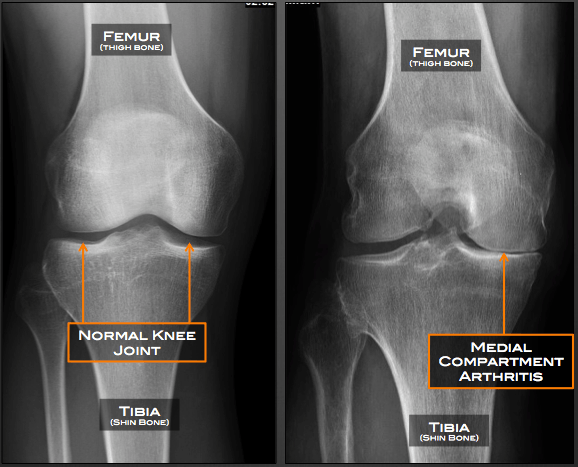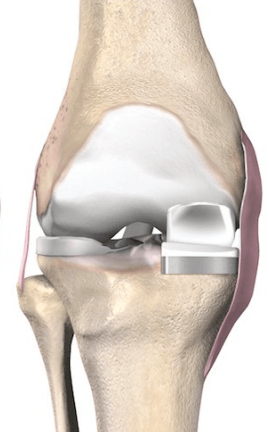Partial (Unicompartmental) Knee Replacement

The x-ray of a normal knee (above left) is shown for comparison to an x-ray of a knee with medial compartment arthritis (above right). Note the complete loss of joint space between the femur (thigh bone) and tibia (shin bone) indicating advanced arthritis in the medial compartment of the knee on the right. The lateral compartment of this knee, however, appears healthy.

In a partial e replacement, the arthritic surfaces of the femur (thigh bone) and tibia (shin bone) in only the arthritic part of the knee are resurfaced with metal and high-strength plastic. The healthy portions of the knee are left intact. Illustration of the Triathlon partial knee replacement, courtesy of Stryker (www.stryker.com).
What is a partial knee replacement?
Partial knee replacement is a treatment for knee arthritis. The knee can be thought of as having three parts, or “compartments”. Total knee replacement is a good treatment option for people with arthritis affecting multiple compartments. Partial, or “unicompartmental”, knee replacement, on the other hand, is reserved for individuals with arthritis limited to only one part of the knee. The most commonly affected area is the medial compartment, located on the inner portion of the knee (see figure below).
Who should have a partial knee replacement?
Partial knee replacement is reserved for people with advanced arthritis affecting one compartment of the knee that does not improve with non-surgical treatment. In these circumstances, partial knee replacement often helps people resume many of their activities and function with significantly less pain.
What is the recovery like?
Partial knee replacement surgery normally includes a brief hospital stay. Physical therapy begins the day of surgery or the following morning. Walking with the aid of a walker and the help of the therapist and hospital staff is encouraged. Most people are ready to go home after 1-2 nights in the hospital. It is helpful to have someone available to provide assistance for the first several days thereafter.
